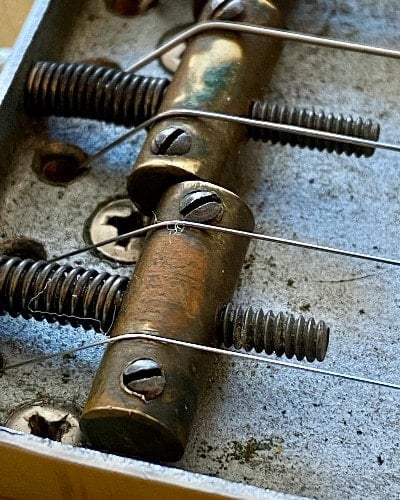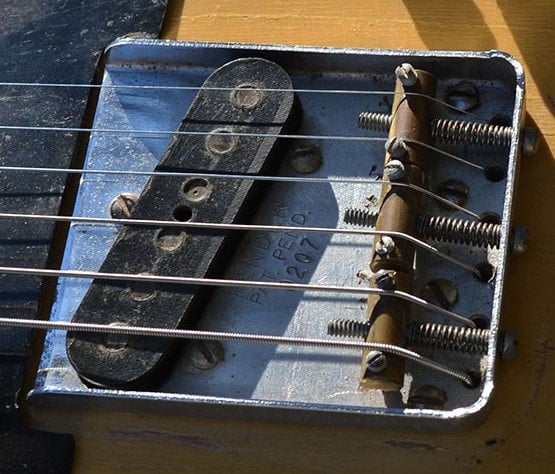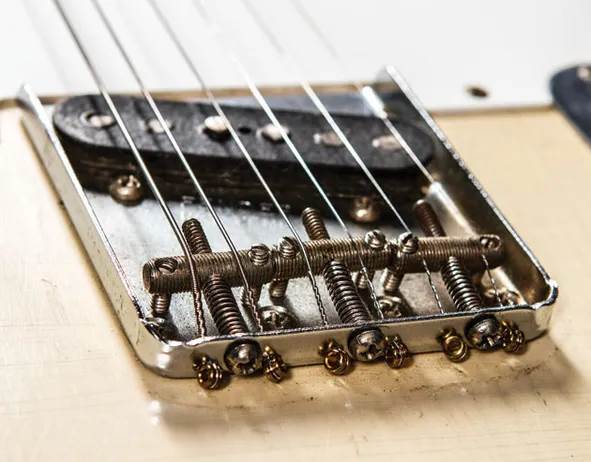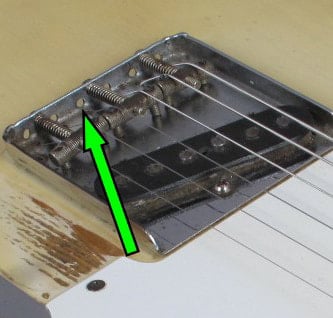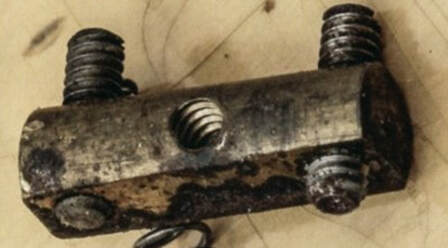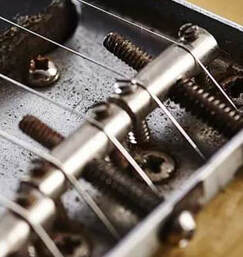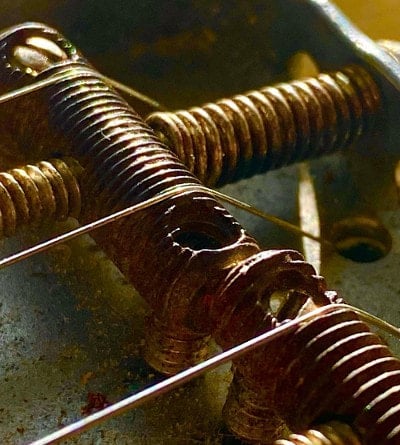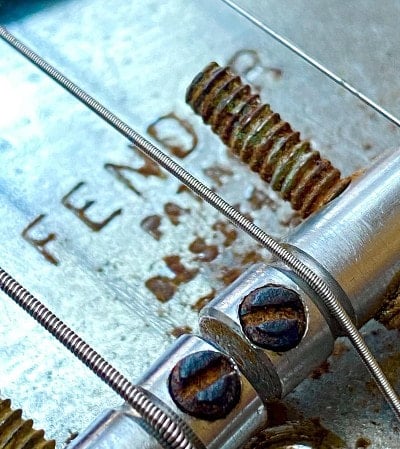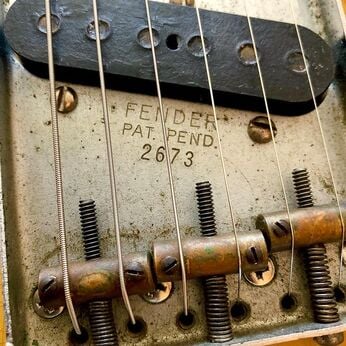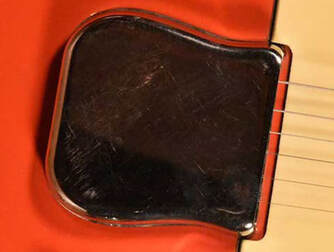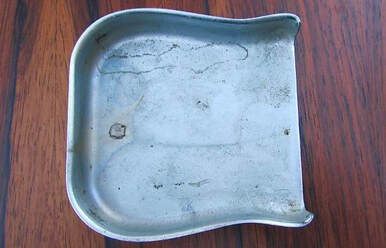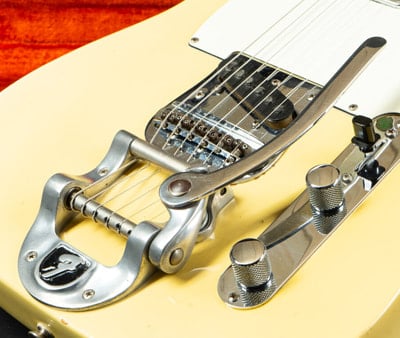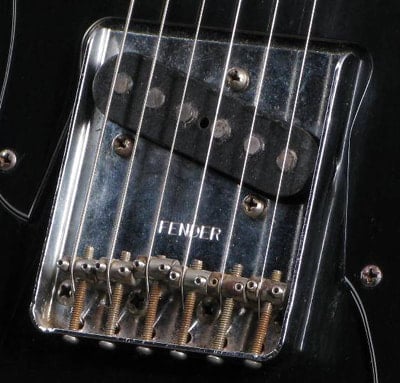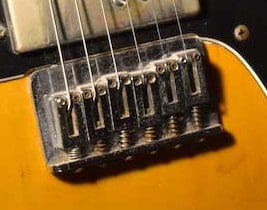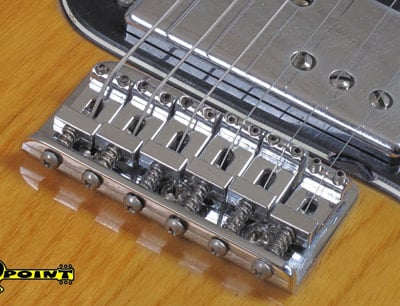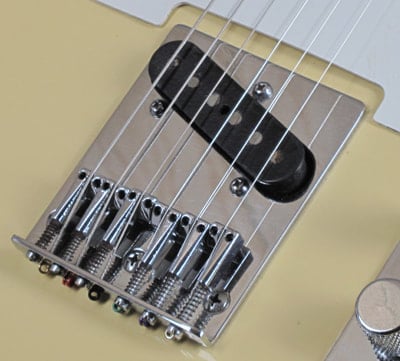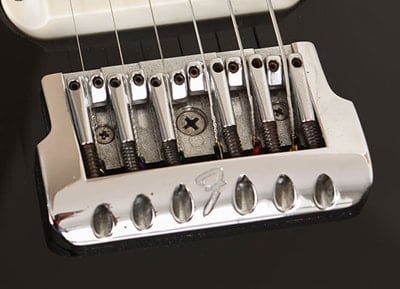With the exceptions of the guitars equipped with a Bigsby vibrato tailpiece, all Esquires, Broadcasters and Telecasters were fitted with the original bridge assembly featured in the patent filed by Leo Fender in January 1950.
Strings were anchored in ferrules inset into the back of the guitar and passing up through holes in the body and through the bridge plate, where they took a right-angle turn over three bridge saddles.
In late '58, the strings-through-body pattern was suspended and replaced for about a year by a top-loading system. On “top loader” guitars, the strings were no longer run through the body, but blocked directly on the plate.
When Fender came back to the original string-through-body pattern, the warehouse inventory of top loader bridge plates was re-drilled with six string holes in the base plate. Hence, late 1959 and 1960 Telecaster bridges usually featured a base plate drilled for both loading systems.
In 1983, the original bridge assembly was discontinued, but a replica was used on the Vintage Reissue model. To avoid any confusion with the original bridge assembly, the base plate of the '52 Vintage Reissue Telecaster featured a small dot stamped below the third number in the serial number.
Strings were anchored in ferrules inset into the back of the guitar and passing up through holes in the body and through the bridge plate, where they took a right-angle turn over three bridge saddles.
In late '58, the strings-through-body pattern was suspended and replaced for about a year by a top-loading system. On “top loader” guitars, the strings were no longer run through the body, but blocked directly on the plate.
When Fender came back to the original string-through-body pattern, the warehouse inventory of top loader bridge plates was re-drilled with six string holes in the base plate. Hence, late 1959 and 1960 Telecaster bridges usually featured a base plate drilled for both loading systems.
In 1983, the original bridge assembly was discontinued, but a replica was used on the Vintage Reissue model. To avoid any confusion with the original bridge assembly, the base plate of the '52 Vintage Reissue Telecaster featured a small dot stamped below the third number in the serial number.
SADDLES
|
- In late October 1950 steel saddles phased out and were replaced by brass saddles, which were cut from 5/16” rod and came grounded flat at the bottom.
- In 1953 the two outer brass saddles were notched to allow for a lower adjustment of both E strings.
- In the Summer of 1954, Fender replaced brass saddles with steel saddles, albeit not ground flat on the bottom and of a slightly smaller diameter than the 1950 sections.
- At the end of 1958 Fender started using threaded steel bridge saddles, with a lower mass.
- Threaded bridge saddles remained the standard appointment until early 1968, when they were superseded by plain steel saddles featuring a groove for each string.
These saddles were kept as a basic trim until 1983.
THE BASE PLATE
Esquires, Broadcasters and Telecasters base plates were machined using Race & Olmsted blanking press and forming die.
|
They were anchored to the body with four mounting screws, although the snake head prototype featured a base plate with three mounting screw holes and open corners.
Between 1950 and late 1954, the base plate sported the instrument's serial number stamped below the “FENDER PAT. PEND.” marking, even though the patent was approved only on 30 October 1951! After late 1954, the serial number was moved on the neck plate and the base plate simply sported the “FENDER PAT. PEND.” marking. Beginning in 1962, the plate was stamped with “FENDER PAT.NO. DES 164227 2,573,254”. These markings remained on the base plate until 1983, with the exception of the '70s six-saddle bridge, which featured only the “FENDER” brand-stamp without any patent number mention. |
THE SNAP-ON COVER
Until mid-1983, Esquire and Telecaster bridge featured a metallic cover, often used by guitarist as a portable ash tray. Since a wire was soldered to the early '50s snap-on cover as a contact for electro-plating in the old days, these units were characterized by a distinctive solder drop (or its mark) on the inner face. Later covers didn't sport any solder drop on the inner face because these units were snapped on racks with spring clips for plating.
The snake head prototype featured a slide-in cover, whilst the cover of the second prototype was anchored to the body with two screws.
The snake head prototype featured a slide-in cover, whilst the cover of the second prototype was anchored to the body with two screws.
OTHER BRIDGE ASSEMBLIES
- The Bigsby tailpiece featured a bridge with six threaded saddles and a base plate without any marking. It was first listed as an option in 1967, even though earlier Telecasters with the Bigsby tailpiece are known to exist.
- In the early '70s, the second version of the Telecaster Custom sported a bridge assembly with six individual steel saddles, which was then available as an accessory to retrofit other Telecaster guitars.
- The second version of the Telecaster Thinline was fitted with the Stratocaster hard-tail bridge with six die-cast saddles and appropriate ash-tray cover.
- The Telecaster Deluxe featured the Stratocaster hard-tail bridge with appropriate bridge cover, although saddles were different from those of the Thinline model. The bottom side of the Deluxe saddle was stamped with “011032” and “1” or “2”. A few Telecaster Deluxe guitars with a complete Stratocaster tremolo bridge assembly are known to exist.
- The 1983 Elite Telecaster featured a new top-loaded die-cast bridge assembly characterized by a massive ridge stamped with a backwards “F” and six elongated saddles. It was designed by Chip Todd and manufactured by Schaller.
- Differently from the original bridge assembly, the 1983 Standard Telecaster bridge featured a longer and thicker chrome-plated brass plate without any side ridges and was characterized by the absence of copper plate at the bottom of the bridge pickup. Like the contemporary Elite Telecaster, it featured six elongated saddles and was designed for top loading system.
- When the American Standard Telecaster was introduced in late 1987, the top loading pattern was discontinued and the bridge assembly was also redesigned with six high density stainless saddles, although the very first guitars were fitted with the '70s style 6-saddle bridge.
MOUNTING SCREWS
In the early days, Leo Fender bought the screws from readily available stock, and therefore he used many different types of screws on prototypes and pre-production guitars.
All the 1950 Telecaster-style guitars featured slot heads screws. In 1951, Fender started a gradual transition towards Phillips heads screws, but the transition was completed by the end of 1953, because Leo Fender didn’t want to waste anything.
The four screws holding the bridge base plate changed to Phillips head in early 1952.
All the 1950 Telecaster-style guitars featured slot heads screws. In 1951, Fender started a gradual transition towards Phillips heads screws, but the transition was completed by the end of 1953, because Leo Fender didn’t want to waste anything.
The four screws holding the bridge base plate changed to Phillips head in early 1952.

